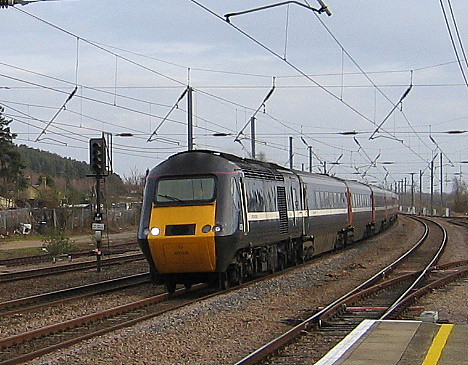This photograph illustrates the problem faced by those trying to find a replacement for the Inter-City 125 trains. The train is diesel powered although the line is electrified.
This train is probably going to Aberdeen, so it will run the 400 miles to Edinburgh under the wires and then continue over the non-electrified part of the route.
It would probably be worth extending the electrification to Aberdeen and it may be that the Scottish parliament will give this the go-ahead. But these trains also run to Bristol, Penzance, Plymouth and Cardiff, and also over other routes which are not likely to be electrified because the civil servants who are now in control believe that some new form of power will be available. If this were to happen, they think any money spent on electrification will be wasted. But so far, the hoped-for new traction system still has to be invented and so the trains will have diesel power for operation over non-electrified routes.
These considerations have given rise to a specification for a train which can run under electric power under the wires and under diesel power over lines which are not electrified. This is the so-called Inter City Express Project (IEP). It is also meant to be able to run at 140mph, weigh less than its predecessors and carry the new European Train Management System for signalling. It is turning out to be the most complex train ever built. And since there is no demand for such a train outside Britain, the production run will be relatively small and the unit costs, which must include research and development, will be high. Which amongst other things will mean that the fleet will be smaller than will really be needed and yet again no doubt, the seats will have to be squeezed in to the already tight British loading gauge to cut costs. Passengers can look forward to yet another cramped and uncomfortable train with insufficient luggage space.
The whole concept is in any case incredibly wasteful. Heavy and costly diesel powered units will be spending much of their time idle, being dragged as deadweight over lines that are electrified.
Whoever has developed the concept has lost sight of the overall picture and presumably is not aware that the problem is not a new one and was solved in a much simpler and more economical way in the past, for example on the Waterloo to Weymouth route. Electric trains were made up from three units each having four cars, with a driving cab at each end. At the London end of the train was a unit with sufficient power to haul another two units which were not powered and had in fact been converted from old stock previously hauled by steam locomotives. The train would run with 12 cars from London and when it reached the end of the electrified line, at Bournemouth, the four-car powered unit was uncoupled and a diesel locomotive attached to the remaining eight cars, which it would haul on to Weymouth. In the reverse direction, the locomotive would push the eight cars to Bournemouth, where it would be attached to a waiting powered 4-car set. The diesel locomotive at the back would be uncoupled and 12 car train would then return to Waterloo under electric power.
The same principle could be applied to whatever replaces the HST. As it is, the project is already becoming overblown and Alstom, one of the competitors, has already pulled out on the grounds that it was consuming too much of the company's engineering resources.
The whole wretched thing, which is likely to run years late and hugely over budget, shows what happens when civil servants are allowed to get involved in the details of engineering projects.
söndag 9 mars 2008
IEP - an expensive mistake in gestation
Prenumerera på:
Kommentarer till inlägget (Atom)
Ultimate net zero lunacy?
The ultimate net zero lunacy is probably de-carbonising and trying to electrify the entire railway system. In the first place, the railways...
-
I wrote to my MP on two entirely separate issues recently. The first was to do with the replacement for the Inter City 125 train, which at £...
-
The ultimate net zero lunacy is probably de-carbonising and trying to electrify the entire railway system. In the first place, the railways...
-
The FT has run a couple of pieces on Sweden this week. The first was a report of the outbreak of car burning, the second, today, on the rise...

Inga kommentarer:
Skicka en kommentar